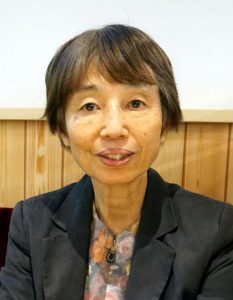To Nihon Hidankyo upon receiving Nobel Peace Prize: Junko Ichiba, chairperson of the Association of Citizens for Supporting South Korean Atomic Bomb Victims, says Hidankyo helped overseas A-bomb survivors to be covered by the relief law
Nov. 13, 2024
The government should compensate for war damage
Jeong Wonsul, president of the South Korean Atomic Bomb Sufferers Association, and Lee Tae Jae, a second-generation atomic bomb survivor, will attend the award ceremony for this year’s Nobel Peace Prize to the Japan Confederation of A- and H-Bomb Sufferers Organizations (Nihon Hidankyo) in Oslo, Norway.
In their announcement of the Nobel Peace Prize, the Nobel Committee said they wished to “honor all survivors.” I am really happy to feel that the words were directed to all survivors of the atomic bombings, including the South Koreans.
The Association of Citizens for Supporting South Korean Atomic Bomb Victims was founded by people from various walks of life in Osaka in 1971, when the late Shin Yong-su of the South Korean sufferers association came to Japan to complain about the plight of South Korean A-bomb survivors. At that time, few survivors and pacifist movement organizations in Japan cared about A-bomb survivors living in South Korea.
A-bomb survivors in Japan were also struggling to survive themselves due to illness and dire poverty, unable to think about others. I think people still had a sense of discrimination (against Koreans) soon after the war.
It was after the enactment of the Atomic Bomb Survivors Relief Law in 1995 that full exchange and cooperation between the South Korean sufferers association and the Nihon Hidankyo began. When survivors in South Korea, the United States and Brazil joined together in solidarity to appeal to the Japanese government to include them in the relief law, which did not apply to those living outside Japan, the Nihon Hidankyo also took the issue as its own.
In 1998, the late Kwak Kwi Hoon, who served as president of the South Korean Atomic Bomb Sufferers Association, filed a lawsuit against the Japanese government, and survivors in Brazil and the United States followed suit.
While fighting in court, we also took other actions, such as lobbying members of the Diet. Thanks to a lot of advice from the people at Nihon Hidankyo accumulated through their campaigning, we were able to have an informal meeting with Diet members from across party lines, which helped change the situation dramatically in a way for overseas survivors to receive benefits. The late So Ito, former co-chair of Nihon Hidankyo, was particularly supportive from early on.
In addition to his formative experience in Hiroshima, Mr. Ito led the movement from the early days of the organization on the basis of his knowledge and theory as an economist. He became a theoretical mainstay of the movement that called for the establishment of a law incorporating compensation by the state.
Mr. Ito proposed “Three Pillars” to solve the problems of atomic bomb survivors, the ideas of which have become the axis of my activities: “Compensation for the past,” to compensate for the damage caused by the atomic bombings as a result of the war instigated by the central government; “Security for the present,” to support the lives of the survivors from the aspect of social security; and “Assurance for the future,” to ensure a world will never be damaged by nuclear weapons.
If we apply this to the South Korean survivors, we can see many problems. A-bomb survivors living abroad are now covered by the relief law, because the Japanese government lost the case and is forced to do so. However, it is limited to the “Security for the present” and not the “Compensation for the past,” the damage wrought by its colonial rule and the war.
We will continue to demand remorse, apology and compensation from the Japanese government and the U.S. government for dropping the atomic bombs in order to lead to the “Assurance for the future.” I think how we will make use of the experience of the survivors’ movements as a problem for humanity is called into question.
(Interviewed by Hiromi Morita, Staff Writer)
Junko Ichiba
Junko Ichiba is a native of Hiroshima Prefecture. She visited South Korea for the first time in 1979, where she learned about the actual conditions of South Korean atomic bomb survivors. Since then, she has been involved in the activities of the Association of Citizens for Supporting South Korean Atomic Bomb Victims. She has been the chairperson of the association since 1999. She is 68 years old and lives in Toyonaka City, Osaka.
(Originally published on November 13, 2024)








